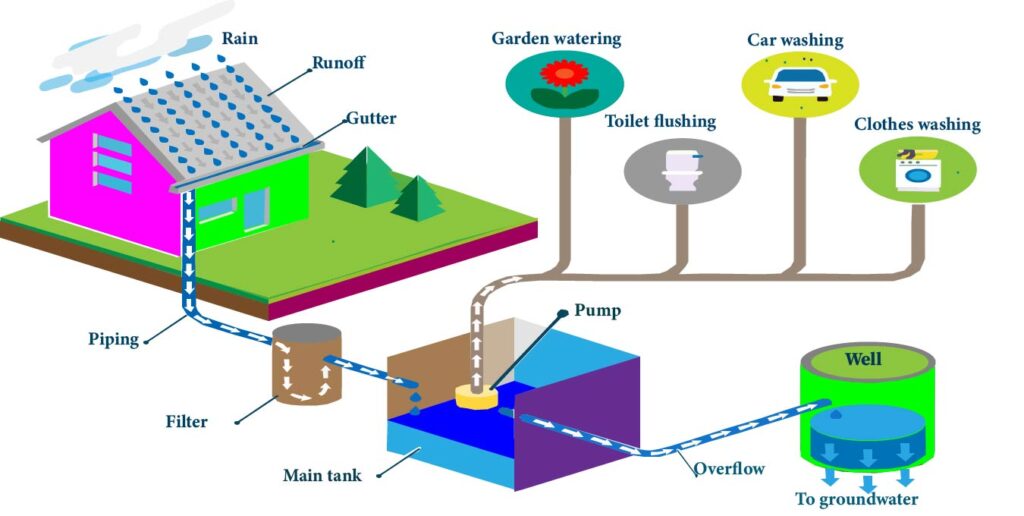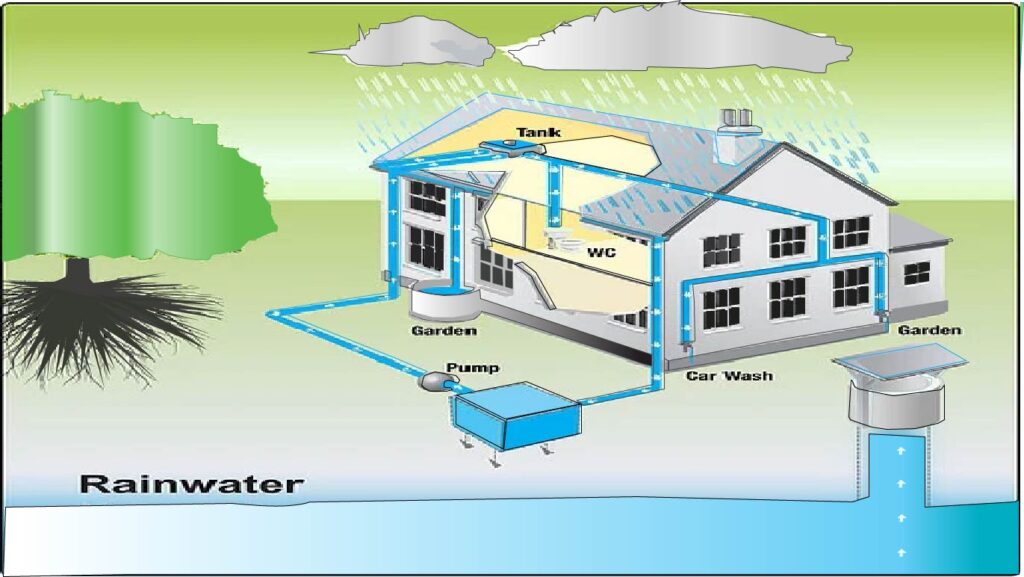TecheSol gives solution of many engineering problems as discussed on home page. You can learn Rainwater Harvesting Methods & Techniques in this topic. Water is the essence of life, and yet, it remains a finite and precious resource. With climate change and rapid urbanization, the world faces a growing water crisis. In such circumstances, water management system is a sustainable solution that allows us to collect, store, and utilize rainwater for various purposes. This blog will explore the concept of Rainwater harvesting techniques, Rainwater irrigation, Water recycling, Water conservation, its benefits, implementation, and its potential to address water scarcity and environmental concerns.

WHAT IS RAINWATER HARVESTING?
Rainwater or stormwater harvesting is an ancient technique that involves capturing rainwater where it falls and storing it for future use. The Rainwater Harvesting Methods & Techniques usually includes collecting rainwater from rooftops, surfaces, and catchment areas, channeling it through gutters and pipes, and directing it into storage tanks or underground reservoirs. This method controls water conservation and solves the problems of rainwater drainage.
RAINWATER HARVESTING METHODS & TECHNIQUES
Rooftop Rainwater Harvesting
This is the simplest method to collect rainwater, which involves gathering rainwater from rooftops and directing it into storage tanks using gutters and downspouts. People primarily use this rainwater collection system for household purposes.
Surface Water Harvesting
In areas with limited rooftop space, rainwater can be collected from other surfaces like paved driveways, sidewalks, or open fields and directed into rainwater collection systems and water is recycled in this way.
Rooftop Gardens
Green rooftops are covered with vegetation, which absorbs rainwater, reduces runoff, and acts as a natural filter. This type of rainwater drainage system helps for roof gardening and clean the water impurities to make it for home use.
Permeable Pavements
This rainwater harvesting technique recycles water by installing permeable materials in sidewalks and driveways, which allow rainwater to pass through and recharge groundwater.
Storm Water Harvesting
Urban infrastructure uses this water management system which involves collecting rainwater from storm water drains and directing it into storage or recharge systems.
Underground Storage
In regions with limited space or a focus on artistic considerations, people use the underground rainwater irrigation technique to collect water in underground tanks and reservoirs.
BENEFITS OF RAINWATER HARVESTING
Groundwater Recharge
Rainwater harvesting system release collected rainwater into the ground which helps to recharge depleted aquifers and maintains a balanced water table and thus recycles the underground water.
Energy Savings
It takes a considerable volume of energy to treat and pump water from distant sources. Rainwater harvesting minimizes the need for such energy intensive processes.
Environment Friendly
Rainwater collection system reduces the demand for dam construction and the diversion of watercourses, both of which have severe biological impacts.
Water Conservation
Rainwater harvesting promotes water conservation by reducing reliance on groundwater and surface water sources. This, in turn, eases the pressure on natural water bodies, ensuring their sustainability.
Mitigating Floods and Soil Erosion
By Rainwater harvesting techniques and rainwater drainage system, especially during heavy rainfall, rainwater harvesting can help mitigate flooding and reduce soil erosion. It helps to slow down the flow of rainwater and allows it to be absorbed into the ground progressively.
Sustainable Water Supply
Rainwater collected by rainwater harvesting techniques can be utilized for non-drinkable purposes such as gardening, washing cars, flushing toilets, and industrial processes. This lowers the demand for treated water from conventional sources, thus supporting sustainable water management.
Improved Water Quality
Rainwater is naturally soft and free from the minerals and chemicals found in groundwater. As a result, it can be used for various applications without requiring heavy treatment processes.
Cost-Effective Solution
Rainwater harvesting can significantly reduce water bills, especially for large commercial or industrial formations. It also provides independence from fluctuating water prices.

CHALLENGES AND SOLUTIONS
While rainwater harvesting offers numerous benefits, there are challenges to its widespread implementation:
Awareness and Education
Many people are unaware of Rainwater Harvesting Methods & Techniques or may be unconvinced about its effectiveness. Increasing awareness and education about the benefits and methods are crucial.
Regulatory Hurdles
In some regions, there might be regulations and policies that hinder the adoption of rainwater harvesting systems. Advocating for supportive policies can help overcome these obstacles.
Initial Investment
Setting up rainwater harvesting infrastructure can involve an initial cost, which may discourage some individuals or organizations.
IMPLEMENTATION OF RAINWATER HARVESTING
The successful implementation of rainwater harvesting involves a few essential steps:
Site Assessment
Site Assessment can be done by analyzing the geographical location, average rainfall, and land characteristics to determine the feasibility and potential of rainwater harvesting.
Collection System
Choose the appropriate collection system based on available space, the intensity of rainfall, and intended use of harvested rainwater.
Filtration and Purification
Install filters and screens to remove debris and contaminants from rainwater. For drinking use, additional treatment methods like UV sterilization may be necessary.
Storage Tanks
Select suitable storage tanks or reservoirs that are durable, non-toxic, and can handle the predicted water demand.
Regular Maintenance
Regularly inspect and clean the system to ensure its efficiency and durability.
CONCLUSION
Rainwater harvesting is a simple yet powerful technique that empowers individuals, communities and industries to become more water-efficient and environmentally responsible. By harnessing the bounty of nature, we can contribute to water conservation, sustainable development, and the preservation of our planet for future generations. As the effects of climate change continue to shape our world, embracing rainwater harvesting becomes an essential step towards securing a water-secure future.

Informative article